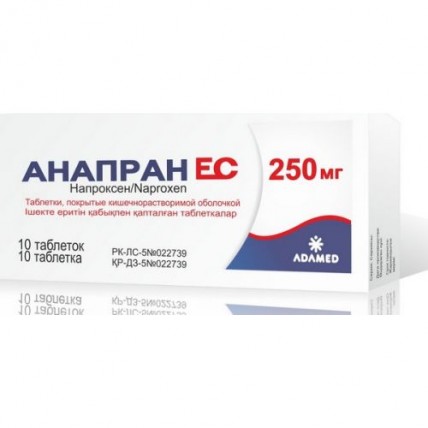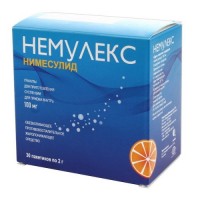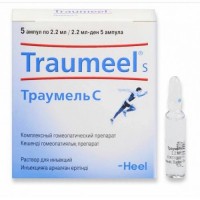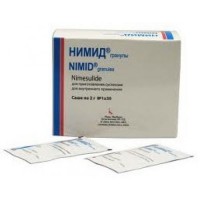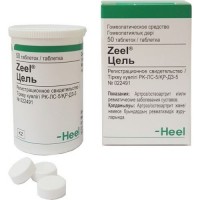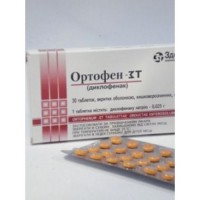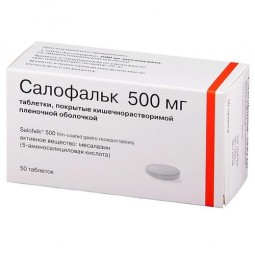EU Anapran 10s 250 mg coated tablets
- $5.20
The instruction for medical use of Anapran medicine of the EU the Trade name Anapran ES the International unlicensed name Naproxenum Dosage Form of the Tablet, covered with a kishechnorastvorimy cover, 250 mg and 500 mg Structure One tablet contains active agent – Naproxenum - 250 mg or 500 mg, excipients: K 90 povidone, kroskarmelloza sodium, magnesium stearate. kishechnorastvorimy cover: methacrylic acid - copolymer ethylacrylic (1:1) dispersion (30%), triethyl citrate, talc the micronized Pharma M, a simetikona an emulsion. The description of the Tablet of round shape, with a biconvex surface, white or almost white color, with a diameter from 10.1 to 10.4 mm (with a dosage of 250 mg) and from 13.1 to 13.5 mm (with a dosage of 500 mg). Pharmacotherapeutic group Anti-inflammatory and antirheumatic drugs. Non-steroidal anti-inflammatory drugs. Propionic acid derivatives. Naproxenum. ATH M01AE02 code the Pharmacological Pharmacokinetics Naproxenum properties is completely soaked up from digestive tract, and peak levels in plasma are reached in 2 - 4 hours. Naproxenum is present at blood, mainly, in not changed look, widely contacts proteins of plasma. The half-life period in plasma is from 12 to 15 hours, promoting achievement of a steady state within 3 days from an initiation of treatment at intake of medicine twice a day. Extent of absorption significantly does not depend on food or the majority of antiacid means. It is removed almost completely with urine, mainly in the form of the conjugated Naproxenum, with some not changed medicinal substance. Metabolism at children is similar to metabolism at adults. The chronic alcoholic liver disease reduces the general concentration of Naproxenum in plasma, but concentration of untied Naproxenum increases. At elderly people, concentration of untied Naproxenum in plasma increases though the general concentration in plasma remains invariable. At administration of Naproxenum in a kishechnorastvorimy cover the peak levels of plasma are reached later in comparison with standard tablets. However average areas under a concentration time curve in plasma and, therefore, biological availability, are equivalent. Tablets work like medicine which does not collapse, will not reach yet a small intestine where there is its fast and full dissolution. The pharmacodynamics Naproxenum has the anti-inflammatory, anesthetizing and febrifugal effect. It has anti-inflammatory effect even on adrenalectomized animals, working directly through a hypophysial and adrenal axis. It is prostaglandinsintetaza inhibitor, as well as other non-steroidal anti-inflammatory drugs. Indications it is intended for symptomatic treatment of a pseudorheumatism, an osteoarthrosis, Bekhterev's disease, sharp skeletal and muscular disorders and dysmenorrheas at patients are more senior than 16 years. A route of administration and doses Therapy has to begin with the lowest recommended dose, especially at elderly people. The Usual dose makes an adult Pseudorheumatism, an osteoarthritis and an ankylosing spondylitis from 500 mg to 1 g a day, is accepted in 2 receptions with a 12-hour interval. If the necessary dose makes 1 g a day, it is recommended to take one 500-mg pill twice a day or two tablets on 500 mg at one time (in the morning or in the evening). In the following cases the load dose in 750 mg or 1 g a day during a sharp phase is recommended: a) At the patients having serious night pains / or morning constraint. b) At the patients transferred to Anapran EC from a high dose of other antirheumatic means. c) In an osteoarthrosis when pain is the main symptom. Acute disorders of the musculoskeletal system and a dysmenorrhea the Initial dose makes 500 mg then, if necessary, the dose decreases up to 250 mg through intervals of 6 - 8-hours, with the maximum daily dose of 1250 mg after the first day of reception. Elderly Researches show that though the general concentration of Naproxenum in plasma is invariable, an untied part of Naproxenum in plasma increases at elderly people. Influence of this opening on dosing Ananpran ES is unknown. As well as in a case with other drugs used by elderly people it is necessary to use the lowest effective dose and during the shortest span as elderly patients are more inclined to emergence of side effects. The patient has to have regular examination for identification of ZhK of bleeding during therapy of NPVP. Information on effect of the lowered improvement at elderly people is provided. Children Anapran ES is not recommended to use by children aged up to 16 years. A renal / liver failure low doses of drug are recommended to Patients with a renal or liver failure. Anapran ES is contraindicated to patients with basic indicators of clearance of creatinine less than 30 ml/min. as at patients with a heavy renal failure or at the patients subject to dialysis, accumulation of metabolites of Naproxenum was traced. Treatment has to be controlled through regular periods and is stopped if no advantage is revealed. Preferably is accepted in time or after a meal. Anapran the EU should be swallowed entirely, not to break and not to crush. Side effects Side effects are grouped according to approach frequency, beginning from the most often noted: very often (≥ 1/10), it is frequent (from ≥ 1/100 to & lt, 1/10), infrequently (from ≥ 1/1000 to & lt, 1/100), is rare (from ≥ 1/10,000 to & lt, 1/1000), is very rare (& lt, 1/10,000). Seldom: hemolytic anemia allergic reactions and reactions of supersensitivity: nonspecific allergic reactions and anaphylaxis, reactions of airways: the including asthmas, the complicated asthma, bronchospasms or dispnoe, or various skin diseases, including: rash of different types, naggers, a small tortoiseshell, a purpura, angio-hypostasis and is more rare an exfoliative bullous dermatosis (including an epidermal necrolysis and a multiformny erythema) a giperkalemiya a hearing disorder a vasculitis asthma, eosinophilic pneumonia a stomacace fatal hepatitis, jaundice an alopecia, a pseudo-porphyria myalgia, muscle weakness Very seldom: thrombocytopenia, a granulocytopenia, a spasm agranulocytosis, aseptic meningitis, a lupus erythematosus, the mixed diseases of connective tissue, with such symptoms as stiff neck, a headache, nausea, vomiting, fever or a disorientation pancreatitis an erythema multiformny, Stephens's syndrome of Johnson, toxic necrosis of epidermis, a bullous epidermolysis glomerular nephrite, a hamaturia, interstitial nephrite, a renal syndrome, medullary necrosis of a kidney Often: nausea, a constipation, vomiting, indigestion confusion of consciousness dizziness, a headache, drowsiness of the Visual disturbance the ring in ears swelled, warm disturbances rash, an itching, a purpura fatigue Infrequently: the depression, cognitive dysfunctions, insomnia, concentration loss, disturbance of dreams the increased heartbeat the increased heartbeat a small tortoiseshell, photosensitivity of the Contraindication hypersensitivity to Naproxenum and Naproxenum-sodium or to any of excipients existence in the anamnesis of symptoms of an allergy in the form of the rhinitis, urticaria or bronchial asthma connected with intake of acetylsalicylic acid or other non-steroidal anti-inflammatory drugs a peptic ulcer of a stomach and (or) duodenum in a phase of aggravation or in the anamnesis, the perforation or bleeding including coming later uses of NPVS a heavy liver failure, a heavy renal failure or heavy heart failure the third trimester of pregnancy and the period of a lactation children's and teenage age up to 16 years hereditary intolerance of fructose, deficiency of Lapp-lactoses enzyme, glucose galactose malabsorption Medicinal interactions Simultaneous introduction antacids or Colestyraminum can delay Naproxenum absorption, but does not influence its action. Simultaneous consumption of food can delay Naproxenum absorption, but does not influence its action. Due to high extent of binding of proteins of plasma Naproxenum, at the patients who are at the same time accepting hydantoins, anticoagulants, other NPVP, the aspirin or sulfonamide which is intensively connecting protein the possibility of overdose has to be excluded by these drugs. As necessary, at the patients who are at the same time accepting Anapran ES and hydantoin, sulfonamide or sulphonylurea it is necessary to regulate a dosage strictly. Simultaneous introduction of NPVP in combination with anticoagulants, such as warfarin or geparins, except for a possibility of direct medical observation, is considered unsafe as NPVP can strengthen effect of anticoagulants. Other analgetics, including selection inhibitors of cyclooxygenase-2. To avoid use of two or more NPVS (including aspirin) as it can increase risk of emergence of side effects. During conduct of clinical trials of interaction of Naproxenum with anticoagulants or sulphonylurea it was not observed, however it is necessary to appoint them with care as interaction with other nonsteroid drugs of this class was traced. It is necessary to appoint with care Anapran ES together with diuretics as it can lead to decrease in diuretic effect. It was revealed that natriuretic influence of furosemide is oppressed by some drugs of this class. Diuretics can increase risk of nephrotoxicity of NPVP. Also the inhibition of renal clearance of lithium leading to increase in concentration of lithium in plasma was traced. Naproxenum and other non-steroidal anti-inflammatory drugs can reduce antihypertensive effect of antihypertensive substances and can increase the risk of developing of a renal failure connected with use of APF inhibitors. At the same time appointed probenetsid increases Naproxenum level in plasma and considerably increases its half-life period. It is necessary to appoint at the same time with care a methotrexate because of possible increase in its toxicity as Naproxenum, together with other non-steroidal anti-inflammatory drugs, reduces tubular secretion of a methotrexate in animal model. NPVP can strengthen heart failure, reduce SKF and increase levels of cardiac glycoside in plasma at simultaneous introduction with cardiac glycosides. With any NPVP it is necessary to appoint at the same time with care cyclosporine because of the increased risk of nephrotoxicity. NPVS should not be applied within 8 - 12 days after administration of mifepristone as NPVS can reduce mifepristone influence. With any NPVP it is necessary to appoint at the same time with care corticosteroids because of the increased risk of developing of gastrointestinal bleeding or an ulcer. The data obtained during the researches on animals show that NPVP can increase risk of developing of the spasms caused by hinolonny antibiotics. The patients accepting hinolona can be exposed to the increased risk of developing spasms. There is an increased risk of developing of gastrointestinal bleeding at a combination of antithrombocytic drugs and selective serotonin reuptake inhibitors (SSRI) to NPVP. There is a possible risk of nephrotoxicity at introduction of NPVP with takrolimusy. There is an increased risk of hematologic toxicity at introduction of NPVP with a zidovudine. There is evidence of the increased risk of developing of a hemarthrosis and a hematoma at HIV (+) the patients with hemophilia receiving simultaneous treatment by a zidovudine and an ibuprofen. It is recommended to stop temporarily therapy by Anapran ES in 48 hours prior to carrying out researches of function of adrenal glands as Naproxenum can artificially disturb some researches because of 17-ketogenic steroids. Similarly, Naproxenum can affect some results of analyses of uric 5-oxyindolacetic acid. Special instructions It is recommended to take the drug the greatest possible short course and in the minimal effective dose necessary for elimination of symptoms. It is long the accepting NPVP, have to have regular medical examination for tracking side effects. The elderly and/or weakened patients are especially inclined to side effects from NPVP, especially to appearance of gastrointestinal bleeding and perforation which can be fatal. Prolonged use of NPVP by these patients is not recommended. If long therapy is required, patients have to be under regular observation. Febrifugal and anti-inflammatory properties Anapran ES can reduce heat and inflammation, thereby reducing their diagnostic manifestation. At the patients suffering from bronchial asthma or allergic diseases or at the patients who had these diseases, medicine can cause a bronchospasm. As well as in a case with other non-steroidal anti-inflammatory drugs, there can be an increase in one or several functions of a liver. Hepatic disturbances can be result of hypersensitivity, but not direct toxicity. At intake of these drugs, as well as in a case with other non-steroidal anti-inflammatory drugs, heavy hepatic reactions were traced, including jaundice and hepatitis (some cases of hepatitis were from the death). Cross-responsiveness cases were noted. Naproxenum reduces aggregation of thrombocytes and prolongs a bleeding time. This effect has to it is necessary to consider when determining duration of bleeding. Though during the metabolic researches of keeping of sodium it was not traced, it is quite possible that patients with problematic or abnormal warm function are exposed to big risks at reception Anapran ES. Gastrointestinal bleedings, ulcerations and perforation At the patients accepting NPVP were traced gastrointestinal bleedings, ulcers or perforation which can have death, during treatment, with existence of the warning symptoms or the endured serious violations of a GIT at any time, or without them. The risk of developing of gastrointestinal bleedings, ulcers or perforation is higher at increase in a dose of NPVP at patients with the endured peptic ulcer, especially if it was complicated by bleeding or perforation and also at elderly people. These patients have to begin treatment with the lowest possible dose. To these patients and also the patients needing the accompanying low dose of aspirin or other drugs increasing risk of gastrointestinal disorders combination therapy with protective equipment has to be appointed (for example, mizoprostoly or inhibitors of a proton pomp). Patients with toxic impact on a GIT in the anamnesis, especially elderly people, have to report about any unusual abdominal symptoms (especially gastrointestinal bleedings), in particular at the initial stages of treatment. With extra care to appoint the patient receiving the accompanying therapy which can increase risk of an ulceration or bleeding, for example, oral corticosteroids, anticoagulants, such as warfarin, some inhibitors of the return capture of a peretonin or antithrombocytic drugs, such as aspirin. When developing gastrointestinal bleeding or an ulceration at the patients accepting Anapran ES, treatment has to be cancelled. NPVP should appoint with care to patients with the postponed gastrointestinal diseases (ulcer colitis, Crohn's disease) as these diseases can be aggravated. Impact on kidneys At intake of Naproxenum cases of renal failures, renal failure, acute interstitial nephrite, hamaturia, proteinuria, renal papillary necrosis and nephrotic syndrome were traced. The renal failure connected with the lowered production of prostaglandin Introduction of NPVP can lead to dose-dependent decrease in production of prostaglandin and developing of a renal failure. Patients with renal failures, heart failure, liver dysfunction, the patients accepting diuretics and elderly people treat the patients who are exposed to this effect. Renal function of such patients has to be under constant control. Reception by patients with disturbance of renal function As Naproxenum substantially (95%) is removed by means of urinarny excretion through a glomerular fil
the radio set, patients should appoint it carefully with renal failures and also to carry out monitoring of creatinine of serum and/or clearance of creatinine at these patients. Anapran the EU is contraindicated to the patients having basic clearance of creatinine less than 30 ml/min. The hemodialysis does not reduce concentration of Naproxenum in plasma because of high extent of binding of proteins. At some patients, especially at patients with disturbance of a renal blood-groove because of exhaustion of extracellular volume, cirrhosis, restriction of sodium, stagnant heart failure and earlier existing renal diseases, it is necessary to perform examination of function of kidneys to and during treatment by Anapran EC. Some elderly patients, with a possible renal failure and also the patients accepting diuretics can also get to this category. In order to avoid excessive accumulation of metabolites of Naproxenum it is necessary to appoint the reduced daily dose. Use by patients with abnormal liver functions the Chronic alcoholic liver disease and, perhaps, other forms of cirrhosis reduce the general concentration of Naproxenum in plasma, but concentration of untied Naproxenum in plasma increases. Influence of this opening on dosing Ananpran ES is unknown therefore it is necessary to use the lowest effective dose. Hematologic reactions to Patients who have disorders of coagulation or receive the medicamentous therapy having negative effect on a hemostasis, it is necessary to appoint with extra care Naproxenum - the containing drugs. The patients subject to high risk of bleeding, or those who are on anti-coagulative therapy (for example, Dicumarinum derivatives) can be exposed to the increased risk of developing of bleeding at a concomitant use Naproxenum - the containing drugs. Anaphylactic (anaphylactoid) reactions of Reaction of hypersensitivity can be observed at supersensitive patients. Anaphylactic (anaphylactoid) reactions can arise as at patients with hypersensitivity to influence of aspirin, other non-steroidal anti-inflammatory drugs or Naproxenum - the containing products, and without it. They can also arise at persons with history of a Quincke's disease, bronkhospastichesky reactions (for example, asthmas), rhinitis and nasal polyps. Anaphylactoid reactions, such as anaphylaxis, can have death. Steroids If the dose of steroids decreases or cleans up therapy process, it has to decrease slowly, and patients have to be under careful observation for identification of any side effects, including adrenal insufficiency and aggravation of symptoms of arthritis. Ophthalmologic effects of the Research did not show the ophthalmologic changes caused by administration of Naproxenum. In rare instances, adverse ophthalmologic disorders, including a papillitis, a retrobulbar optic neuritis and papilloedy, were observed at the patients accepting NPVP, including Naproxenum though cause and effect cannot be established, respectively, the patients suffering from ophthalmologic disturbances during treatment Naproxenum - the containing drugs have to undergo ophthalmologic inspection. Influence on a cardiovascular and vascular and brain system Patients with the postponed hypertension and/or slight - moderate stagnant heart failure have to be under careful observation as therapy of NPVP can cause a delay of liquid and hypostasis. Clinical trials and epidemiological data demonstrate that use of koksib and some NPVS (especially, at high doses and long-term treatment) can lead to slight increase of risk of arterial trombotichesky complications (for example, a myocardial infarction or a stroke). Though data demonstrate that lower risk can accompany Naproxenum use (1000 mg a day), some risks cannot be excluded. Patients with uncontrollable arterial hypertension, the stagnant heart failure diagnosed by coronary heart disease, diseases of peripheral arteries and/or cerebrovascular diseases have to accept Naproxenum after carrying out the careful analysis. The analogical analysis needs to be carried out also prior to long-term treatment of patients with risk factors of cardiovascular diseases (for example, a hypertension, a lipidemia, diabetes, smoking). The hard currency and the mixed disease of connective tissue At patients with the system lupus erythematosus (SLE) and the mixed disease of connective tissue can exist the increased risk of aseptic meningitis. Dermatological reactions were Seldom or never observed serious skin reactions, some of them from the death, including exfoliative dermatitis, Stephens-Johnson's syndrome and a toxic epidermal necrolysis caused by use of NPVP. The highest risk of emergence of these reactions was traced at the beginning of a therapy course: in most cases signs of reactions appeared within the first month of treatment. At the first appearance of skin rash, defeats mucous or any other sign of hypersensitivity intake of Naproxenum should be stopped. The precautionary measures connected with the genital Naproxenum Use function, or its combinations to any drug inhibiting synthesis of cyclooxygenase / prostaglandin can affect fertility, and it is not recommended to the women trying to become pregnant. To women who experience difficulties with conception or undergo inspection on infertility, it is necessary to stop intake of Naproxenum. The combination to other NPVP the Combination Naproxenum - the containing products and other NPVP, including selection inhibitors of cyclooxygenase-2, is not recommended because of cumulative risks of induction serious NPVP-svyazannykh side effects. Use at pregnancy and during breastfeeding According to the available data, introduction of NPVP can cause congenital anomalies in the person, however the probability of such anomalies is low and has no accurately outlined characteristics. As well as other drugs of this type, Naproxenum causes a delay of childbirth in animals and also influences the cardiovascular system of a human fruit (closing of an arterial channel). NPVP should not be used during the first two trimesters of pregnancy if the potential advantage for the patient does not exceed potential risk for a fruit. Features of influence on ability to run vehicles, mechanisms. Some patients can test drowsiness, dizziness, loss of spatial orientation, insomnia, fatigue, a disorder of vision or a depression at use Anaprana ES. If patients test these or similar undesirable effects, they should not drive the car or to operate mechanisms. Overdose Symptoms. Heartburn, nausea, vomiting, pain in epigastriums, gastrointestinal bleedings belongs to symptoms a headache, it is rare - diarrhea, a disorientation, excitement, drowsiness, dizziness, sonitus, faints. In cases of serious poisoning the acute renal and liver failure is possible. After intake of NPVP the disturbance of breath and a lump can be traced, however such cases are rare. In one of overdose cases the transitional increase in a prothrombin time in connection with a gipotrombinemiya was connected by Naproxenum with selection inhibition of synthesis vitamin of K-dependent factors of coagulation. Treatment. Treatment of patients is appointed depending on symptoms. Within one hour after reception of potentially toxic amount of the drug it is necessary to take activated carbon. As an alternative for adults, within one hour after reception of potentially life-threatening dose of drug it is necessary to make gastric lavage. It is necessary to provide an intensive diuresis. It is necessary to control functions of a liver and kidneys carefully. Patients have to be under observation within not less than four hours after reception of potentially toxic amounts of drug. Frequent or long spasms should be eliminated with the diazepam entered intravenously. Depending on a clinical condition of the patient other measures can be taken. The hemodialysis does not reduce concentration of Naproxenum in plasma because of high extent of binding of proteins. Nevertheless, carrying out a hemodialysis is reasonable at the patients with a renal failure who accepted Naproxenum. The form of release and packing On 10 tablets place in blister strip packaging from a film of the polyvinylchloride and printing aluminum foil varnished. On 1 planimetric packing together with the instruction for use in the state and Russian languages place in a box cardboard Storage conditions to Store in original packing at a temperature not higher than 25 Store OS out of children's reach! A period of storage 2 years Prescription status According to the prescription the Applicant of Adamed Limited Liability Company Pieńków 149, 05-152, Czosnów, Poland Pharmaceutical Works Polfa in Pabianice Joint Stock Company Producer. 5, marsz. J. Piłsudskiego Str., 95-200 Pabianice, Poland the Owner of the registration certificate of Adamed Limited Liability Company Pieńków 149, 05-152, Czosnów, Poland the Address of the organization accepting in the territory of the Republic of Kazakhstan claims from consumers on quality of products (goods) and responsible for post-registration observation of safety of medicine Representative office of JSC Pabianice Pharmaceutical Plant Polfa in PK 059000, Almaty, the street of Abay, house 109B, business center "Globus", floor 13, office 13-2.
To develop
the radio set, patients should appoint it carefully with renal failures and also to carry out monitoring of creatinine of serum and/or clearance of creatinine at these patients. Anapran the EU is contraindicated to the patients having basic clearance of creatinine less than 30 ml/min. The hemodialysis does not reduce concentration of Naproxenum in plasma because of high extent of binding of proteins. At some patients, especially at patients with disturbance of a renal blood-groove because of exhaustion of extracellular volume, cirrhosis, restriction of sodium, stagnant heart failure and earlier existing renal diseases, it is necessary to perform examination of function of kidneys to and during treatment by Anapran EC. Some elderly patients, with a possible renal failure and also the patients accepting diuretics can also get to this category. In order to avoid excessive accumulation of metabolites of Naproxenum it is necessary to appoint the reduced daily dose. Use by patients with abnormal liver functions the Chronic alcoholic liver disease and, perhaps, other forms of cirrhosis reduce the general concentration of Naproxenum in plasma, but concentration of untied Naproxenum in plasma increases. Influence of this opening on dosing Ananpran ES is unknown therefore it is necessary to use the lowest effective dose. Hematologic reactions to Patients who have disorders of coagulation or receive the medicamentous therapy having negative effect on a hemostasis, it is necessary to appoint with extra care Naproxenum - the containing drugs. The patients subject to high risk of bleeding, or those who are on anti-coagulative therapy (for example, Dicumarinum derivatives) can be exposed to the increased risk of developing of bleeding at a concomitant use Naproxenum - the containing drugs. Anaphylactic (anaphylactoid) reactions of Reaction of hypersensitivity can be observed at supersensitive patients. Anaphylactic (anaphylactoid) reactions can arise as at patients with hypersensitivity to influence of aspirin, other non-steroidal anti-inflammatory drugs or Naproxenum - the containing products, and without it. They can also arise at persons with history of a Quincke's disease, bronkhospastichesky reactions (for example, asthmas), rhinitis and nasal polyps. Anaphylactoid reactions, such as anaphylaxis, can have death. Steroids If the dose of steroids decreases or cleans up therapy process, it has to decrease slowly, and patients have to be under careful observation for identification of any side effects, including adrenal insufficiency and aggravation of symptoms of arthritis. Ophthalmologic effects of the Research did not show the ophthalmologic changes caused by administration of Naproxenum. In rare instances, adverse ophthalmologic disorders, including a papillitis, a retrobulbar optic neuritis and papilloedy, were observed at the patients accepting NPVP, including Naproxenum though cause and effect cannot be established, respectively, the patients suffering from ophthalmologic disturbances during treatment Naproxenum - the containing drugs have to undergo ophthalmologic inspection. Influence on a cardiovascular and vascular and brain system Patients with the postponed hypertension and/or slight - moderate stagnant heart failure have to be under careful observation as therapy of NPVP can cause a delay of liquid and hypostasis. Clinical trials and epidemiological data demonstrate that use of koksib and some NPVS (especially, at high doses and long-term treatment) can lead to slight increase of risk of arterial trombotichesky complications (for example, a myocardial infarction or a stroke). Though data demonstrate that lower risk can accompany Naproxenum use (1000 mg a day), some risks cannot be excluded. Patients with uncontrollable arterial hypertension, the stagnant heart failure diagnosed by coronary heart disease, diseases of peripheral arteries and/or cerebrovascular diseases have to accept Naproxenum after carrying out the careful analysis. The analogical analysis needs to be carried out also prior to long-term treatment of patients with risk factors of cardiovascular diseases (for example, a hypertension, a lipidemia, diabetes, smoking). The hard currency and the mixed disease of connective tissue At patients with the system lupus erythematosus (SLE) and the mixed disease of connective tissue can exist the increased risk of aseptic meningitis. Dermatological reactions were Seldom or never observed serious skin reactions, some of them from the death, including exfoliative dermatitis, Stephens-Johnson's syndrome and a toxic epidermal necrolysis caused by use of NPVP. The highest risk of emergence of these reactions was traced at the beginning of a therapy course: in most cases signs of reactions appeared within the first month of treatment. At the first appearance of skin rash, defeats mucous or any other sign of hypersensitivity intake of Naproxenum should be stopped. The precautionary measures connected with the genital Naproxenum Use function, or its combinations to any drug inhibiting synthesis of cyclooxygenase / prostaglandin can affect fertility, and it is not recommended to the women trying to become pregnant. To women who experience difficulties with conception or undergo inspection on infertility, it is necessary to stop intake of Naproxenum. The combination to other NPVP the Combination Naproxenum - the containing products and other NPVP, including selection inhibitors of cyclooxygenase-2, is not recommended because of cumulative risks of induction serious NPVP-svyazannykh side effects. Use at pregnancy and during breastfeeding According to the available data, introduction of NPVP can cause congenital anomalies in the person, however the probability of such anomalies is low and has no accurately outlined characteristics. As well as other drugs of this type, Naproxenum causes a delay of childbirth in animals and also influences the cardiovascular system of a human fruit (closing of an arterial channel). NPVP should not be used during the first two trimesters of pregnancy if the potential advantage for the patient does not exceed potential risk for a fruit. Features of influence on ability to run vehicles, mechanisms. Some patients can test drowsiness, dizziness, loss of spatial orientation, insomnia, fatigue, a disorder of vision or a depression at use Anaprana ES. If patients test these or similar undesirable effects, they should not drive the car or to operate mechanisms. Overdose Symptoms. Heartburn, nausea, vomiting, pain in epigastriums, gastrointestinal bleedings belongs to symptoms a headache, it is rare - diarrhea, a disorientation, excitement, drowsiness, dizziness, sonitus, faints. In cases of serious poisoning the acute renal and liver failure is possible. After intake of NPVP the disturbance of breath and a lump can be traced, however such cases are rare. In one of overdose cases the transitional increase in a prothrombin time in connection with a gipotrombinemiya was connected by Naproxenum with selection inhibition of synthesis vitamin of K-dependent factors of coagulation. Treatment. Treatment of patients is appointed depending on symptoms. Within one hour after reception of potentially toxic amount of the drug it is necessary to take activated carbon. As an alternative for adults, within one hour after reception of potentially life-threatening dose of drug it is necessary to make gastric lavage. It is necessary to provide an intensive diuresis. It is necessary to control functions of a liver and kidneys carefully. Patients have to be under observation within not less than four hours after reception of potentially toxic amounts of drug. Frequent or long spasms should be eliminated with the diazepam entered intravenously. Depending on a clinical condition of the patient other measures can be taken. The hemodialysis does not reduce concentration of Naproxenum in plasma because of high extent of binding of proteins. Nevertheless, carrying out a hemodialysis is reasonable at the patients with a renal failure who accepted Naproxenum. The form of release and packing On 10 tablets place in blister strip packaging from a film of the polyvinylchloride and printing aluminum foil varnished. On 1 planimetric packing together with the instruction for use in the state and Russian languages place in a box cardboard Storage conditions to Store in original packing at a temperature not higher than 25 Store OS out of children's reach! A period of storage 2 years Prescription status According to the prescription the Applicant of Adamed Limited Liability Company Pieńków 149, 05-152, Czosnów, Poland Pharmaceutical Works Polfa in Pabianice Joint Stock Company Producer. 5, marsz. J. Piłsudskiego Str., 95-200 Pabianice, Poland the Owner of the registration certificate of Adamed Limited Liability Company Pieńków 149, 05-152, Czosnów, Poland the Address of the organization accepting in the territory of the Republic of Kazakhstan claims from consumers on quality of products (goods) and responsible for post-registration observation of safety of medicine Representative office of JSC Pabianice Pharmaceutical Plant Polfa in PK 059000, Almaty, the street of Abay, house 109B, business center "Globus", floor 13, office 13-2.
To develop
